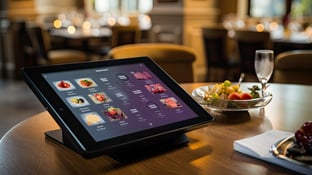Note: Updated August 26, 2025.
Is your restaurant outgrowing your current point of sale (POS) system? It’s true that transitioning from your old POS software can be a source of stress and operational disruption. But the long-term benefits of switching to a new restaurant POS system far outweigh the short-term growing pains of making this transition.
But how do you know when to switch to a new restaurant POS software? After all, moving your entire operation over to a new platform does come with a number of practical challenges. So before you make the move, you want to be sure the timing is right.
Knowing When to Switch to a New Restaurant POS
For some restaurants, the need to transitioning to a new restaurant POS system may be pretty obvious. If your system is glitchy, inefficient, or prone to lag time, it’s clear that the time to upgrade is now.
But the same is also true if your legacy POS system simply doesn’t integrate with new platforms and applications for important operational functions like order/delivery, accounting, CRM (customer relationship management), and inventory management.
In reality, many legacy POS systems function as little more than electronic cash registers. Many of the advanced POS features that are standard today were handled with pen and paper not too long ago. If this is still the case for your restaurant business, then it means your data is siloed and your operation is missing opportunities for greater efficiency, cost-effectiveness, and data analysis.
Even if your legacy system is basically functional, you may be falling behind the competition without even realizing it.
Ditching the Legacy POS System
Sustainable seafood restaurant group Seamore’s, which has six locations around New York City, found itself at this very crossroads just a few years ago. We spoke with Seamore’s CEO, Jay Wainwright, who told us that it was becoming increasingly difficult to manage his growing operation on a rapidly aging POS system. That’s when his operation made the switch to Toast and its industry-leading suite of POS solutions.
“It was becoming clear that the company we were using had kind of lost its way in terms of investing in the evolving universe of things that a POS can help with,” Wainwright said. “Toast’s open platform model is much more dynamic. On-premise transactions are tied to the same database that our website and all the order and delivery apps feed into. For a small operator like Seamore’s, that’s a game-changer.”

Download the Free POS Guide
Find the best POS system for your restaurant with this expert-vetted guide.
*Submitting this form will also subscribe you to our weekly newsletter. Unsubscribe at any time.
Another factor that motivated Wainwright to switch to Toast was the need for more features. Today, QR codes are widely used for both mobile ordering and on-premise payment.
“That whole process was pretty much a fantasy, say, five years ago,” Wainwright said. “Our previous POS company didn’t offer anything comparable, so Toast was the more attractive choice.”
The bottom line? If your restaurant is operating on an outdated platform and you’re not sure exactly when to switch POS systems, the time is now!
Signs It’s Time to Switch POS Systems
Not sure if your current POS system is holding your restaurant back? Use this quick checklist to figure out if it's time to make a change:
- Frequent crashes or slow performance: Your system stalls during peak hours or regularly needs rebooting.
- No mobile or tablet/iPad support: You're tied to fixed terminals and can’t take orders tableside or on the go.
- Limited or outdated inventory tracking: You’re still updating stock manually or can't track ingredient-level inventory in real time.
- Lacks integrations with third-party tools: Your POS doesn’t sync with your payroll, online ordering, or delivery platforms.
- No customer relationship features: You can’t collect customer data, offer loyalty rewards, or track visit history.
- Poor reporting or analytics: You're flying blind when it comes to sales trends, staff performance, or menu insights.
- Difficulty training new staff: The system is clunky or non-intuitive, leading to a longer onboarding process and more user errors.
- No offline functionality: If the internet connection goes out, you lose access to everything, including open tickets.
3 Benefits of Switching to a New Restaurant POS System
As Wainwright’s experience suggests, failing to make the switch to a new restaurant POS may mean falling behind in a fiercely competitive industry. But beyond these pressures, consider the added benefits of switching to a new restaurant POS:
- Moving to the Cloud
If your restaurant is using an aging POS, chances are your system is based entirely on-premises. On-premise systems work off a server that lives at your restaurant. If you want to access the system remotely — a necessity for owner-operators running multi-location businesses — your POS won’t be up to the task.
On-premise POS systems are also especially vulnerable to security threats like data theft, fire, and outages. This is why a majority of restaurateurs are pivoting away from these traditional “legacy” systems.
Among the biggest benefits of switching to a new restaurant POS system is the opportunity to move to a cloud-based system, one in which your servers are off-premise, hosted in secure facilities by a reliable third-party vendor, and accessible to you from anywhere in the world.
Check out our deeper dive into the differences between on-premise and cloud-based POS systems.
2. Lower Hardware Costs
Not only are cloud-based systems more accessible and secure, but they also offer a more cost-effective solution. In fact, those aging legacy POS systems are actually quite expensive. Monthly rental fees for costly on-premise hardware may be costing you far more than you need to spend.
“A long time ago," said Wainwright. "When all you had were these behemoth companies like Aloha and Micros, a full set of terminals was a huge capital expense. If you were a big company with lots of restaurants, it could cost hundreds of thousands of dollars.”
Wainwright notes that the hardware associated with Toast costs a far more manageable $6,000 per location.
3. Ease of Implementation
Wainwright also points out that one of the biggest benefits of switching to a new restaurant POS is how easy it is from a technological standpoint.
“It used to be a much harder process, and it involved a lot of loss,” Wainwright said. “In the old days, when the only option was to switch from one legacy system to another, you had to completely write off and get rid of all your existing equipment — which, again, cost you a ton — because it wasn’t compatible with the new system.”
On the other hand, said Wainwright, “The switch from one cloud-based system to another was ultimately really simple, and Toast had a good road map for us to follow.”
What To Look for in a New POS System
Once you’ve decided to make a change, the next step is finding the best POS system that fits your restaurant’s unique needs. Here are the key features and qualities to prioritize when evaluating new options:
- User-friendly: Your staff should be able to pick up the system quickly with minimal training. Look for a clean, intuitive interface and responsive design that works across devices.
- Mobile and tableside functionality: Modern POS systems should support tablets and smartphones, allowing staff to take orders, accept payments, and split checks directly at the table.
- Integration capabilities: The right POS system will play well with others, whether that’s accounting software, online ordering platforms, customer loyalty programs, or labor management tools. Seamless integration reduces manual work and syncs your operations.
- Real-time reporting and analytics: Detailed, customizable reports on sales, labor, menu performance, and more help you make smarter decisions. Bonus points if you can access them from your phone.
- Flexible payment processing: Ensure your POS supports multiple payment types, such as credit cards, EMV chips, contactless (NFC), gift cards, and mobile wallets like Apple Pay or Google Pay.
- Offline mode and data security: The system should keep running during internet outages and offer built-in encryption to protect sensitive customer and business data.
- Strong support and onboarding: Look for 24/7 customer support, clear documentation, and personalized onboarding to make setup and training smooth.
- Scalability: Whether you're running one location or planning to grow, your POS should be able to scale with you, adding new terminals, menus, and locations with ease.
5 Ways To Ensure Successful Implementation of a New POS
While the technological implementation of a new POS may be relatively straightforward, the path to smooth organizational adoption may take a bit more work. There are a few steps you’ll want to take to prepare for, and ensure the success of, implementing your new POS system.
1. Do Your Due Diligence
To truly enjoy the benefits of switching to a new restaurant POS system, it’s important to choose the right provider for your needs and ambitions. Vet possible POS providers with a few factors in mind:
- Verify that the system has the features you need and integrations that are compatible with your existing systems.
- Request full details on base pricing, hardware rental costs, and whether or not the vendor requires a long-term contract.
- Ask about payment processing. Find out if the company offers, or even requires you to use, integrated processing applications, and if so, what their rates are.
It’s worth noting that many cloud-based operations like Toast and Square may call for relatively inexpensive hardware, but they may also require you to use their proprietary payment gateways. In some cases, these integrated processors may impose higher fees than the standalone processors that can be used with a variety of other systems.
2. Prepare for Migration
Before you get rid of your outbound POS system, you’ll need to move your operation onto the new platform. That means cleaning up the data in your existing system — including menu items and pricing information, loyalty data, and inventory levels — before migrating this information to the new systems. Once you’ve ensured your data is accurate and up-to-date, your provider should be able to help you transfer it to your new POS system.
3. Transition Gradually
There are likely to be some bumps on the road to transition. For this reason, Wainwright advises that you keep the old system running for a bit before you phase it out completely.
“In the years when I was overseeing switches from one legacy system to another, we’d run into these massive problems involving outlet placement, because everything had to be hard-wired,” Wainwright said. “Most of our equipment now is handheld, but we still had some issues. The hardest part was making sure all the devices were routed to the correct printers. We had the bar tickets printing to the kitchen for a little bit, which was kind of a disaster.”
Avoid disaster by switching to a new POS in gradual phases. Don’t trash the old system until the new one is operating smoothly
4. Onboard Your Team
Even if the technical process of implementing a new POS platform is easy for your restaurant, the transition can be challenging for the staff who will ultimately use this technology. Without the proper preparation, it may even come as a bit of a culture shock for your personnel.
Look for a vendor that provides training, onboarding materials, and comprehensive customer support. And expect your team to experience a bit of a learning curve, even under the best conditions.
To the point, restaurant tech consultant Luisa Castellanos of Science on Call encourages operators not to “make the switch on a busy weekend or during the holidays. It might disrupt service, but it’ll definitely throw your team for a loop. Give your team enough time to learn the system, and, if possible, arrange for them to do a few test runs before going live.”
5. Understand Your New POS
The real benefits of switching to a new restaurant POS only truly emerge when you learn the full scope of your system’s capabilities. Andy Freivogel, the CEO of Science on Call, urges restaurant operators to understand their systems to the best of their ability.
“Sometimes restaurant owners who are changing from one system to another don’t even realize that they have to switch processors,” he said. “Then, when the new system goes live, the money isn’t flowing where it should, and you’ve got a huge mess to sort out.”
“In the case of the worst go-live I’ve ever seen,” Freivogel said, “the POS company did nothing to ascertain site readiness, and the staff was not trained on the new system at all.”
Find the Best POS Provider for Your Restaurant
This underscores the importance of choosing both a system that matches your needs and a vendor that understands your goals. The only way to ensure that you match up with the right platform and provider is to begin by doing some research into trustworthy POS vendors.
Not sure where to start? Talk to a Back of House tech expert to explore your options.





